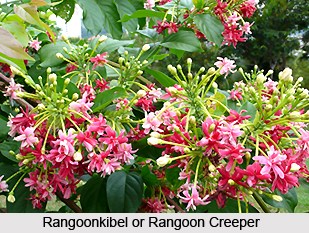 Rangoonkibel is an Indian Medicinal Plant that possesses the scientific name, Quisqualis indica. It is a tropical plant and is cultivated in gardens throughout India, up to an altitude of 300 meters. Rangoonkibel is known in various names in different languages , it is known as Chinese honeysuckle or Rangoon creeper in English; barmasi or barma sinivel in Gujarati; Rangoon kempu malle in Kannada; lalchameli or rangun-chaval in Marathi; ilengaramalligai or irangun-malli in Tamil; ettaguttilativva, rangonimalle or tigeganneru in Telugu.
Rangoonkibel is an Indian Medicinal Plant that possesses the scientific name, Quisqualis indica. It is a tropical plant and is cultivated in gardens throughout India, up to an altitude of 300 meters. Rangoonkibel is known in various names in different languages , it is known as Chinese honeysuckle or Rangoon creeper in English; barmasi or barma sinivel in Gujarati; Rangoon kempu malle in Kannada; lalchameli or rangun-chaval in Marathi; ilengaramalligai or irangun-malli in Tamil; ettaguttilativva, rangonimalle or tigeganneru in Telugu.
The Indian Medicinal Plant, Rangoonkibel is a large, woody and climbing shrub. Each leaf of this plant grows in opposite or sub-opposite direction. These leaves are elliptic or elliptic-oblong in shape with an acuminate tip and a rounded base. The Rangoonkibel plant margins entirely, that is glabrous above and hairy from beneath. This Indian Medicinal plant bears leaves with variable size. They are usually 7.5 to 10 cm long and 3.5 to 4 centimetres wide. The petioles are 7.5 mm long with 6 to 8 pairs of main nerves. The flowers of Rangoonkibel are fragrant and come in white or red colour. The calyx of the flowers tubular and triangular in shape. All flowers of this medicinal plant bear pendulous axillary racemes. The petals have 6 cm long and pubescent acute lobes and they are lanceolate, acute with 1.3 cm long.
Rangoonkibel has dry, coriaceous fruits that are ovate-elliptic in shape. The fruits are up to 4 cm long and 1.3 cm broad. In this medicinal plant the fruits are acutely 5-angled or 5-winged and 1-seeded. These flowers are nearly available all the year round in India; however they bloom mainly in March and April in central India. The flowers change their colour from the moment they blossom. They are white upon opening in the evening; gradually turn into pink by morning and deep red by late after-noon.
Rangoonkibel has essential medicinal properties and uses. Each part of the plant possesses remedial agents. The fruits, seeds and extracts from both the roots and leaves hold anthelmintic properties. The fruits are picked from this Indian Medicinal plant when half ripe and bitter. They are pulped in water and the water is useful when taken internally. The sweet ripe seeds also possess soporific properties, although they must be taken in strict moderation and not more than 4 per dose. An overdose of this can lead to unconsciousness. These ripe seeds are roasted and used to treat diarrhoea and fever. It is also useful in Indochina as the seeds are used to treat rickets in children. In addition to that these seeds are used as an external application to treat parasitic skin diseases also as they possess macerated in oil. Oil extracted from the seeds includes purgative properties. The juice of leaves from this Indian Medicinal Plant is used as a lotion to relieve boils and ulcers. Young shoots of the Rangoonkibel can be eaten raw or steamed as a vegetable.



















